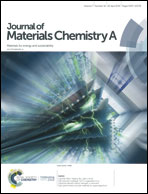A new approach for synthesizing bulk-type all-solid-state lithium-ion batteries†
Abstract
All-solid-state Li-ion batteries (ASSLiB) have been considered to be the next generation energy storage devices that can overcome safety issues and increase the energy density by replacing the organic electrolyte with inflammable solid electrolyte. However, the synthesis of high ionic conductivity electrolyte and fabrication of ASSLiB are still the main challenges. In this work, we propose a new methodology to fabricate ASSLiB by inducing the lithium ionic conductive binder to integrate the NASICON-structured solid electrolyte with two electrodes. The ionic binder was systematically investigated to understand its physical, chemical, and electrochemical properties through various characterization techniques. A prototype of the ASSLiB was finally fabricated in the ambient conditions using LiNi0.5Mn1.5O4 as the cathode, RuO2 as the anode, and the ionic conductive thermosetting material as the binder. The ionic conductivity of 1.03 × 10−4 S cm−1 was obtained for this ASSLiB. The discharge capacity of the ASSLiB was measured to be 87.5 mA h g−1 at 0.2C and room temperature for 120 cycles, and 146 mA h g−1 at 0.5C and 50 °C for 43 cycles, respectively.



 Please wait while we load your content...
Please wait while we load your content...